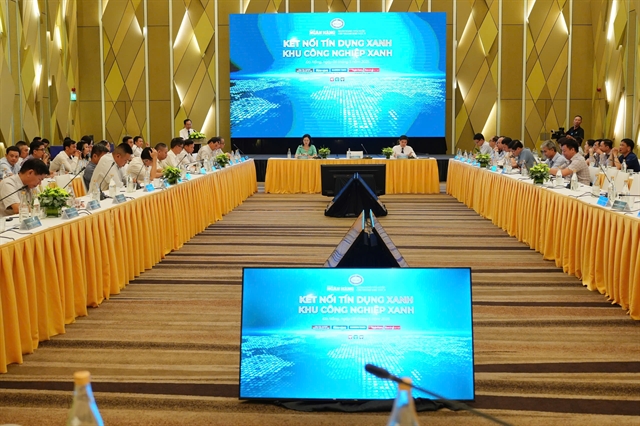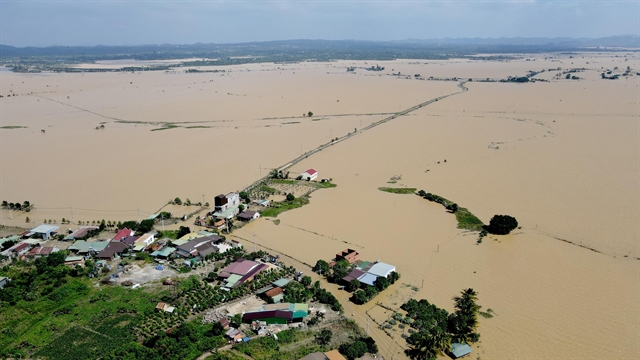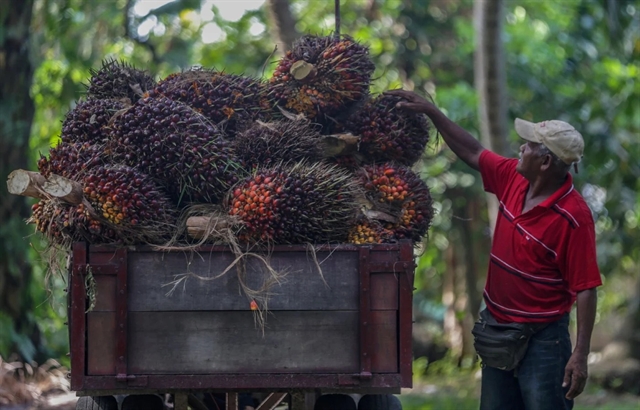 Economy
Economy


|
| View of the forum. — VNS Photo |
HÀ NỘI — Though the State Bank of Vietnam (SBV) has issued many policies to encourage green credit, the promotion of such credit to support the building and expansion of green industrial parks still faces many challenges, mainly because the criteria for recognising such green industrial parks are currently not explicitly defined.
SBV Deputy Governor Đào Minh Tú said that green credit in Việt Nam has many favourable conditions and opportunities for development, thanks to clear orientations and regulations.
“The SBV has issued a series of policies and guiding documents to strongly encourage the development of green credit. It has also actively cooperated closely with international organisations to build a list of 12 priority green sectors, creating a clear reference framework for green credit activities,” Tú told the forum on green credit and green industrial zones last Friday.
Under the SBV’s direction, there are now 50 credit institutions funding green credit, up from only 15 in 2017. The average growth rate of green outstanding loans in the 2017-24 period reached more than 22 per cent per year, higher than the growth rate of the entire economy.
However, Tú said, green loans only account for about 4.6 per cent of total outstanding loans, showing that green credit in Việt Nam remains modest compared to the size it could achieve.
Green credit promotion to support the building and expansion of green industrial parks still faces many challenges. The list of green industries and fields is not yet nationally unified, so commercial banks have difficulty in selecting, appraising, evaluating and monitoring when granting such credit. Moreover, the lack of available land and buffer zone for development is also among the difficulties in expanding green industrial parks.
Of the 290 industrial parks operating in Việt Nam, between one and two per cent of them are taking steps to become eco or green industrial parks.
At the event, the Deputy Head of the Management Board of Economic Zones and Industrial Parks of Quảng Nam Province, Lê Quang Triều, said: "To successfully transform green and build green industrial parks, it is necessary to create favourable conditions for businesses to access green credits with preferential interest rates, loan terms or conditions, to encourage businesses to implement green and environmentally friendly projects."
Triều proposed measures to effectively implement connections, including establishing a separate green credit fund for green industrial parks, issuing clear and specific criteria for evaluating green industrial parks to support quick credit approval, and building a risk-sharing mechanism between the State, banks and enterprises.
The General Director of BIDV, Lê Ngọc Lâm, said, to promote green credit, it is necessary to complete the legal framework to support green businesses. Though Circular No. 05/2025/TT-BKHĐT of the Ministry of Planning and Investment has initially provided important guidelines on the development of ecological industrial parks, stronger and more synchronous policies are needed to truly promote the process of economic model transformation. In particular, it is necessary to build breakthrough incentive policies on tax, credit and investment for green businesses and businesses applying the circular economic model.
“We recommend that the Government issue low-interest green credit packages for environmental protection, renewable energy and clean technology projects soon. At the same time, establish a national green investment fund with the participation of both the public and private sectors, with clear criteria and transparent processes. It is also necessary to promote incentives for research and development (R&D) and application of environmental technology, as well as supporting domestic enterprises to produce environmentally friendly products and improve competitiveness in the international market,” Lâm said.
In addition, he said that the Government should create a synchronous and effective green financial ecosystem, with close coordination between banks, enterprises and State management agencies. On that basis, it is necessary to continue to perfect the legal framework for green financial instruments such as green bonds, green credit, and green insurance, with a unified system of criteria that is easy to apply and aligns with international practices.
“Clear and transparent regulations will be the foundation for credit institutions such as BIDV to assess, classify and grant green credit in a more professional and effective manner,” Lâm explained. — BIZHUB/VNS




